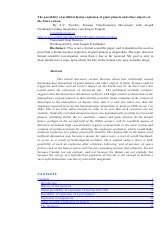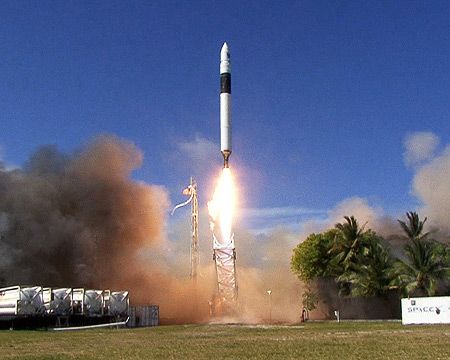I wrote an essay on the theme of the possibility of artificial initiation and fusion explosion of giants planets and other objects of Solar system. It is not a scientific article, but an atempt to collect all nesessary information about this existential risk. I conclude that it could not be ruled out as technical possibility, and could be made later as act of space war, which could clean entire Solar system.
Where are some events which are very improbable, but which consequence could be infinitely large (e.g. black holes on LHC.) Possibility of nuclear ignition of self-containing fusion reaction in giant planets like Jupiter and Saturn which could lead to the explosion of the planet, is one of them.
Inside the giant planets is thermonuclear fuel under high pressure and at high density. This density for certain substances is above (except water, perhaps) than the density of these substances on Earth. Large quantities of the substance would not have fly away from reaction zone long enough for large energy relize. This fuel has never been involved in fusion reactions, and it remained easy combustible components, namely, deuterium, helium-3 and lithium, which have burned at all in the stars. In addition, the subsoil giant planets contain fuel for reactions, which may prompt an explosive fire — namely, the tri-helium reaction (3 He 4 = C12) and for reactions to the accession of hydrogen to oxygen, which, however, required to start them much higher temperature. Substance in the bowels of the giant planets is a degenerate form of a metal sea, just as the substance of white dwarfs, which regularly takes place explosive thermonuclear burning in the form of helium flashes and the flashes of the first type of supernova.
The more opaque is environment, the greater are the chances for the reaction to it, as well as less scattering, but in the bowels of the giant planets there are many impurities and can be expected to lower transparency. Gravitational differentiation and chemical reactions can lead to the allocation of areas within the planet that is more suitable to run the reaction in its initial stages.
The stronger will be an explosion of fuse, the greater will be amount of the initial field of burning, and the more likely that the response would be self-sustaining, as the energy loss will be smaller and the number of reaction substances and reaction times greater. It can be assumed that if at sufficiently powerful fuse the reaction will became self-sustaining.
Recently Galileo spacecraft was drawn in the Jupiter. Galileo has nuclear pellets with plutonium-238 which under some assumption could undergo chain reaction and lead to nuclear explosion. It is interesting to understand if it could lead to the explosion of giant planet. Spacecraft Cassini may soon enter Saturn with unknown consequences. In the future deliberate ignition of giant planet may become a mean of space war. Such event could sterilize entire Solar system.
Scientific basis for our study could be found in the article “Necessary conditions for the initiation and propagation of nuclear detonation waves in plane atmospheras”.
Tomas Weaver and A. Wood, Physical review 20 – 1 Jule 1979,
http://www.lhcdefense.org/pdf/LHC%20-%20Sancho%20v.%20Doe%20…tion-1.pdf
It rejected the possibility of extending the thermonuclear detonation in the Earth’s atmosphere in Earth’s oceans to balance the loss of radiation (one that does not exclude the possibility of reactions, which take little space comparing the amount of earthly matter — but it’s enough to disastrous consequences and human extinction.)
There it is said: “We, therefore, conclude that thermonuclear-detonation waves cannot propagate in the terrestrial ocean by any mechanism by an astronomically large margin.
It is worth noting, in conclusion, that the susceptability to thermonuclear detonation of a large body of hydrogenous material is an ex¬ceedingly sensitive function of its isotopic com¬position, and, specifically, to the deuterium atom fraction, as is implicit in the discussion just preceding. If, for instance, the terrestrial oceans contained deuterium at any atom fraction greater than 1:300 (instead of the actual value of 1: 6000), the ocean could propagate an equilibrium thermonuclear-detonation wave at a temperature £2 keV (although a fantastic 10**30 ergs—2 × 10**7 MT, or the total amount of solar energy incident on the Earth for a two-week period—would be required to initiate such a detonation at a deuter¬*ium concentration of 1: 300). Now a non-neg-ligible fraction of the matter in our own galaxy exists at temperatures much less than 300 °K, i.e., the gas-giant planets of our stellar system, nebulas, etc. Furthermore, it is well known that thermodynamically-governed isotopic fractionation ever more strongly favors higher relative concentration of deuterium as the temperature decreases, e.g., the D:H concentration ratio in the ~10**2 К Great Nebula in Orion is about 1:200.45 Finally, orbital velocities of matter about the galactic center of mass are of the order of 3 × 10**7 cm /sec at our distance from the galactic core.
It is thus quite conceivable that hydrogenous matter (e.go, CH4, NH3, H2O, or just H2) relatively rich in deuterium (1 at. %) could accumulate at its normal, zero-pressure density in substantial thicknesses or planetary surfaces, and such layering might even be a fairly common feature of the colder, gas-giant planets. If thereby highly enriched in deuterium (£10 at. %), thermonuclear detonation of such layers could be initiated artificially with attainable nuclear explosives. Even with deuterium atom fractions approaching 0.3 at. % (less than that observed over multiparsec scales in Orion), however, such layers might be initiated into propagating thermonuclear detonation by the impact of large (diam 10**2 m), ultra-high velocity (^Зх 10**7 cm/sec) meteors or comets originating from nearer the galactic center. Such events, though exceedingly rare, would be spectacularly visible on distance scales of many parsecs.”
Full text of my essay is here: http://www.scribd.com/doc/8299748/Giant-planets-ignition
 I wrote an essay on the theme of the possibility of artificial initiation and fusion explosion of giants planets and other objects of Solar system. It is not a scientific article, but an atempt to collect all nesessary information about this existential risk. I conclude that it could not be ruled out as technical possibility, and could be made later as act of space war, which could clean entire Solar system.
I wrote an essay on the theme of the possibility of artificial initiation and fusion explosion of giants planets and other objects of Solar system. It is not a scientific article, but an atempt to collect all nesessary information about this existential risk. I conclude that it could not be ruled out as technical possibility, and could be made later as act of space war, which could clean entire Solar system.
